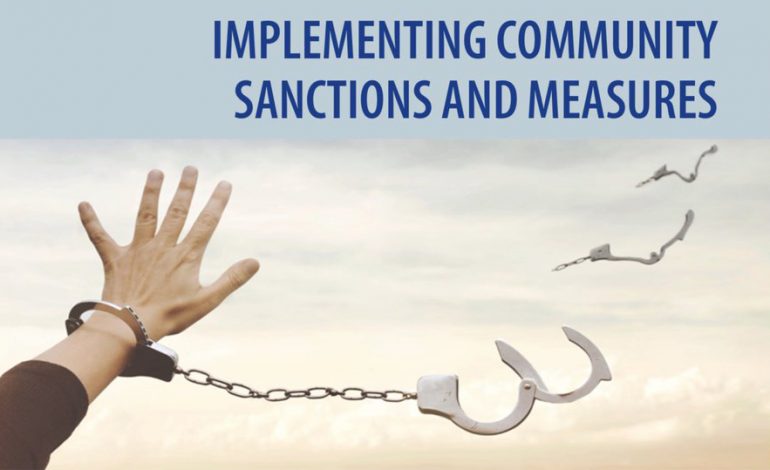The value of the European Rules on community sanctions and measures (CSM)
For the past thirty years in Europe and in many others parts of the world, prison and probation agencies have been preoccupied with the question of ‘What Works?’. This is an attempt to find out which regimes, methods and programmes succeed in reducing re-offending (or, more accurately, rates of reconviction). The starting point of the Council of Europe, however, is different. Effectiveness matters (of course), but penal policies and practices must uphold and promote the human rights affirmed in the European Convention.
John Rawls, one of the most influential philosophers of the twentieth century, wrote:
‘Justice is the first virtue of social institutions, as truth is of systems of thought. A theory however elegant and economical must be rejected or revised if it is untrue; likewise laws and institutions no matter how efficient and well-arranged must be reformed or abolished if they are unjust.’[1]
In other words, ‘what’s right?’ must come before ‘what works?’ The human rights of people charged with or being punished for crimes are especially vulnerable. Here the power of states is laid bare and potentially oppressive and the international regulation of punishment has accordingly become increasingly important[2]. A problem, however, is that many convention rights are unavoidably framed in very general terms. Article 3, for example, declares ‘No one shall be subjected to torture or to inhuman or degrading treatment or punishment.’ In principle, no one should disagree with this, but its precise implications are far from clear. Imprisonment, most obviously, involves any number of hardships, pains, humiliations and privations and the point at which these amount to a violation of Article 3 is not self-evident.
The European Court of Human Rights can develop the precise implications of the Convention by establishing case law, but can only rule on applications received, most commonly associated with alleged violations, infringements, and loss of liberties. At times, too, the Court has been overwhelmed by the amount of its business and, while new procedures have been introduced to tackle a ‘massive backlog’[3], delays can still be considerable. If the determination of precisely what some rights entail in practice awaits the rulings of the Court, the wait could be a long one.
It is here that the work of the Council of Europe can be invaluable. The Council for Penological Co-operation (PC-CP) tries to work out the precise implications of the Convention for imprisonment and for community sanctions and measures and then to frame Rules. This Committee is made up of people elected in an individual capacity from the 47 member states, with experts often appointed to bring specialist advice to specific projects. Most members of the Committee have extensive practical experience of management and practice in prison services and / or probation agencies, ensuring that their work remains properly grounded in the realities of penal practice. The Committee members’ experience of the challenges of practice not only gives authority to their opinions, but also ensures that hard, specific questions are properly addressed. Some of the rights of offenders are deliberately or unavoidably taken away or limited by the sentence of the court, but the PC-CP works out in detail how, within these parameters, rights may be protected and enhanced. The Rules that emerge from the Committee’s deliberations are thus both realistic and principled.
Texts of Rules and Recommendations are in due time and after further careful scrutiny adopted by the Committee of Ministers (the Council’s decision-making body)[4]. This process entails an ‘ownership’ by the member states that bestows a significant authority on the Rules. They are not legally binding, but the European Prison Rules have been cited by the European Court of Human Rights in explaining their judgements. Applications may require the Court to think about the purpose and character of imprisonment, for example, and the Court can draw upon the reasoning and conclusions of the Council to help it to come to its decisions.
Essentially these sets of Rules involve relatively detailed and specific working out of the liberties – and often the claims[5] – required by the Convention. In this way, Rules can respond to the potential limitations of remoteness and abstraction, drawing out what it will mean in practice to respect the rights of offenders, victims, criminal justice staff and the community – and how to resolve conflicts of rights in a principled way. Rights may then become the beginning and the focus of policy. Unless policy is set securely on this foundation, there is a real risk that rights may come to be seen as marginal or, even worse, as obstacles to effectiveness or efficiency. As David Garland has insisted, however,
‘… the pursuit of values such as justice, tolerance, decency, humanity and should be part of any penal institution's self-consciousness - an intrinsic and constitutive aspect of its role - rather than a diversion from its “real” goals or an inhibition on its capacity to be “effective”.’[6]
The practices of punishment should be concerned with much more than the efficient administration of the sentences of the courts. The Rules aspire to ensuring that, rather than being seen as obstacles frustrating punitive or reductive purposes, human rights become the foundation and inspiration of policy and practice.
Constructing the Rules
The Council of Europe has long appreciated that the rights of people held in prison and other places of detention are especially precarious. Establishing Rules to regulate the conditions of imprisonment was accordingly of singular importance. The Council based its initial Recommendation in 1973 on the United Nations Standard Minimum Rules for the Treatment of Prisoners[7]. These European Prison Rules were revised in 1987 and again in 2006 as Recommendation Rec (2006)2[8].
The preamble to the Prison Rules declares that ‘no one shall be deprived of liberty save as a measure of last resort’. This principle recognises the intrinsic threat of degradation and assaults on human dignity that incarceration poses and the misery and squalor of so many prisons across the continent. The Council has therefore championed the use of community sanctions and measures (CSM) that can accomplish legitimate penal purposes as well as – and usually much better than - imprisonment. The term alternatives to custody, incidentally, is preferably avoided: not only does this expression over-simplify the complex relationship between prison and CSM, as will be discussed later in this paper, but it seems to instate prison as a norm against which other sanctions should be measured. If CSM are to command the confidence of the judiciary and the general public, however, and contribute to reducing the resort to imprisonment, the principles that should guide their deployment must be made explicit. Moreover CSM make demands on people, which may include restrictions on liberty - for example, requiring them to attend at specified places for supervision; to participate in certain activities (for instance offending behaviour programmes); limiting their movements (exclusions from named areas); confining them to their places of residence at particular times (curfews); or making them work for nothing (community service)[9]. All of this raises questions about rights.
In part inspired by the United Nations Standard Minimum Rules for Non-custodial Measures (The Tokyo Rules)[10], Recommendation R (92) 16 on the European Rules on Community Sanctions and Measures was adopted by the Committee of Ministers in October 1992. The Rules were accompanied by an Explanatory Memorandum or Commentary. While this text does not have the formal status of the Rules, it sets out the rationale for each rule and can provide valuable detail to countries attempting to put the Recommendation into effect. Eight years later, a further Recommendation was adopted - Recommendation Rec (2000) 22 on improving the implementation of the European rules on community sanctions and measures. This made just one formal amendment to the 1992 Rules[11], but the opportunity was taken in a lengthy Appendix to set out further regulation and guidance, supported again by a Commentary. Interestingly, the formal amendment was said to have been introduced because at least four member states had not been able to put the original rule into effect. The texts also refer to the findings of a survey to find out about how states had experienced attempts to implement the Rules. Reporting back on these experiences is a critical element in the processes of their development (see further below).
Over the next fifteen years, as the types of CSM increased and their use proliferated, even as prison numbers in many countries also rose, the Council decided that the Rules were in need of a comprehensive review and commissioned the PC-CP to undertake this work. The author of this paper was appointed as an expert to advise the PC-CP. My task was to draw up successive drafts of a set of Rules which would then be discussed at meetings of the PC-CP in Strasbourg. The text was progressively redrafted under the Committee’s guidance. Most of the debate took place in Committee, but it was recognised that the practice experiences of member states would be an invaluable resource. With the assistance of the Confederation of European Probation (CEP), the thoughts of member states were canvassed and, as part of the drafting process, a conference was held in Zaandam in the Netherlands where participants were given an opportunity to comment on the draft and contribute to its improvement. Once agreed, these Rules were presented as a draft Recommendation that was submitted first to the European Committee on Crime Problems (CDPC) and in due course proposed to the Committee of Ministers for formal adoption[12].
The Council’s wisdom in commissioning a complete revision immediately became apparent as soon as this work began. The 2000 text on improving implementation had not superseded the original 1992 Recommendation – nor was it intended to. But apart from the single formal amendment, many areas were revisited and some new material was introduced. The consequence of this was that there were two set of Rules, covering much the same ground, but with a different numbering and often a different emphasis. To see the point of the Rules, reference had to be made to two Commentaries as well, so that study of the Rules involved an attempt to combine four documents. The new text, as it sets out in its preamble, was intended to replace both these earlier Recommendations[13].
As discussion began in Committee, an important initial point was to echo the principle affirmed in the Probation Rules that the CSM Rules are intended to apply to any organisation that delivers some or all of the relevant services. In some countries, for example, this is not a ‘probation agency’, but a local authority or some other agency. There are also countries (including England and Wales) who are seeking to involve other organisations, whether the independent / NGO or the commercial sector, in the delivery of these services. The Committee wanted to insist that the Rules must apply to any organisation involved: the state must not abdicate its responsibilities to respect human rights by devolving this work to an organisation that could then claim its independence from the state and try to argue that its work was not covered by these Rules.
As always in drawing up international rules, there were difficulties of terminology and translation. Some technical terms can be explained in a glossary, but (for example) words denoting probation, community service, staff and service users (if such terms are known at all in all languages) can carry different connotations. It is not many years ago that within the single jurisdiction of England and Wales with a common language there was heated debate about whether those under community supervision should be called offenders[14] or clients or probationers or service users or something else. These debates were all about connotation. Professor Martine Herzog-Evans has discussed these matters perceptively and (with examples that are especially pertinent for this Recommendation) asks:
‘Does a given word, such as for instance the universally used ‘probation’, have the same meaning in all languages? Are the words used in probation perceived in a negative or positive way? For example, the word ‘community’ cannot possibly be literally translated into French. On the one hand, in French, its literal translation, ‘communauté’, does not have the same meaning as community. For this reason it is actually best translated into ‘société’ (or society) when referring to a group of people, and into ‘milieu ouvert’ (open world) when referring to community sentences. On the other hand, ‘communauté’ can have a rather negative connotation: France is a republic which was built on the grounds of an ideal of unification and centralism. Communities are thus perceived as threatening the nation as a whole.’[15]
More generally, all languages have words and expressions that carry significance and connotation and cannot be simply translated by a notional equivalent in another language. This is not to say that these words cannot be understood by non-native speakers, but to understand them fully calls for a sufficient appreciation of the contexts in which they are used. Since the Rules were to be translated into the national languages of all member states, the Committee had to anticipate and guard against ways in which they could be misunderstood.
Another central challenge was to construct a set of Rules that could be ‘owned’ by the member states, with their different traditions and legal and organisational arrangements. The Rules are to guide policy and practice, but, unless they are vague, they are highly likely to call some national practices into question. National arrangements and practices must be respected, but some practices may need to change to conform to the Council’s ethical standards. Indeed this is precisely the main purpose of the Rules. There is always the risk with Rules that, if they call for changes that some countries cannot accept, they might simply be ignored.
The CSM Rules
The Committee of Ministers formally adopted Recommendation CM/Rec (2017) 3 on the European Rules on community sanctions and measures on 22 March 2017[16].
The text was organised in this way:
Chapter I: Basic principles
Chapter II: Legal framework
Chapter III: Community sanctions and measures: implementation and methods
Chapter IV: Community participation
Chapter V: Consent, cooperation and enforcement
Chapter VI: Non-compliance and revocation
Chapter VII: Organisation, staff, and resources
Chapter VIII: Inspection, monitoring and complaints procedures
Chapter IX: Research, evaluation, work with media and the public
Chapter X: Reviewing of the Rules
Instead of a glossary, the Recommendation includes (a very few) ‘Definitions’ to avert misunderstanding. Unusually, the Rules and Explanatory Memorandum are woven together in a single text, with the relevant commentary inserted immediately after the Rule. There was discussion about this. Some felt that since the Commentary does not have the formal status of the Rules, the texts should be kept separate, but the convenience and ‘user friendliness’ of a single document outweighed that concern.
This paper will make no attempt to discuss the Rules individually, which are readily available in all national languages of the member states. A few general comments should be made.
Chapter I commends the use of CSM and points out the many ways in which they are to be preferred to prison. At the same time, it is recognised that while CSM can be rehabilitative, but they are often also ‘coercive, prohibitive, intrusive’. This immediately raises questions about the implications for human rights. Chapter I in general champions CSM, but is alert to the challenges involved in their implementation.
Chapter IV represents an attempt to set out the responsibilities of the community. The defining characteristic of CSM is that they are non-custodial, but Chapter IV envisages a fuller contribution from and engagement with the community. In other words, ‘community’ should mean more than merely ‘not-in-prison’. This reflects the belief, amply supported by research[17], that desistance[18] from crime is much more likely to take place where individuals can benefit from social inclusion and fair access to the resources of civil society. Even if the law does not directly bar access to services and resources, some of these might even so remain effectively unavailable because of the distinct needs and circumstances of (most obviously) former prisoners. Probation and associated agencies may have to advocate on behalf of people with convictions and liaise with responsible agencies, recognising that social inclusion must accompany changes in ex-offenders’ attitudes and behaviour if desistance is to be achieved.
Chapters V and VI attend to the fundamental questions of enforcement and compliance. The challenge of securing compliance is peculiar to community sanctions and measures: CSM require people to do things - to keep appointments as instructed, to participate in (or refrain from) activities, to work – which they might otherwise choose not to do. This creates the possibility of default. It is true that at its most ambitious, imprisonment seeks to engage the participation of prisoners in an active and purposeful rehabilitative endeavour, but a passive or recalcitrant prisoner is still being punished; an unenforced community penalty, by contrast, is indistinguishable from impunity - from ‘getting away with it’. In the attempt to establish its credibility as punishment, attempts are sometimes made to emphasise the demanding content of community punishment. But of course this all comes to nothing unless the punishment is given effect. This is the challenge of compliance: ensuring that offenders fulfil their obligations in accordance with the law and the order of the Court. Nurturing consent is both more effective and more respectful than threat. Chapter V insists that, even whether or not an expression of consent is formally required when a CSM is imposed, efforts must always be made to obtain the full understanding of those subject to CSM and their informed consent to what is taking place. This may not always be possible and certainly there are times when individuals’ choices may be over-ridden by other factors, but even then this must be explained with care so that people can see that their interests are never simply ignored.
As in earlier editions of the Rules, these chapters insist that a breach or failure to comply must not lead to an automatic custodial sentence. Similarly, in some jurisdictions, people who have served a community sanction may be legally ineligible or considered unsuitable for another CSM, a penal tariff then hurrying them along into prison. The Rules accordingly state that countries should do all they can to make sure that there are no formal obstacles to the use of CSM for repeat offenders. This is exceptionally important if CSM are to contribute to reducing numbers of prisoners.
There are political demands for CSM to be punitively burdensome, with more and more conditions and requirements. This increases the likelihood of default[19]. There are also reasonable expectations of strict enforcement, while judges sometimes feel that default means that a last chance has not been taken so that prison must now be unavoidable. All this introduces the possibility that CSM could even tend to increase numbers of people in prison. This is a particularly pointed matter for those released early from imprisonment under some form of licence. Increasing numbers of people are in prison not because of the offences they have committed or even on the basis of the risks they are believed to pose, but have been recalled to prison because of their failure to comply with the requirements of supervision[20].
Putting the Rules to work
One of the principal duties of the Council is to set standards and the hope was that Ministries of Justice, managers and practitioners in probation agencies and / or those tasked with undertaking the relevant practices would study the Rules carefully. They might then initiate some type of audit to see if their practices complied with the Rules, using the Recommendation as a benchmark. If this exercise was done, there might be three possible outcomes:
1. Policy and practice may comply with the Rules.
A key distinction that needs to be made immediately is between the impact or influence of the Rules and, on the other hand, conformity or compliance with these Rules. It may be, for example, that a country’s organisations, policies and practices are substantially in accordance with the Rules, but have not been influenced by them: rather, their practices may have already been in place and have not changed because of the Rules. This seems likely: after all, the content of the Rules was the outcome of the deliberations of a Committee whose members have extensive experience of penal affairs. It was the experience of their own agencies and their own conceptions of good practice that they drew on when drafting the Rules. Yet whether standards were introduced or existing good practice merely confirmed, the exercise of evaluating what is already taking place against the benchmark of the Rules would be an instructive and worthwhile activity.
2. Practice may fall short of the Rules and efforts might be made to raise standards.
The Rules would then be a stimulus to better policies and practices. By no means all member states have well-established agencies or traditions of CSM and of those that do some are new and developing. The Rules would be of value here to guide strategic planning and implementation. The Explanatory Memorandum would be a useful resource, explaining the rationale of every rule and often providing helpful detail.
3. Practice may be better than the Rules and / or put the Rules to test.
This third possibility is in some ways the most interesting. It is entirely possible that practice in some places goes beyond the requirements of the Rules. Again, even in a Committee with such long and rich experience, deliberation is relatively theoretical and remote: the test for the Rules is whether they can be put into practice. At the same time, implementation could perhaps have effects unforeseen by the Council, some of which may be undesirable.
This kind of audit, then, and actions taken in response to the findings, were the Council’s first aspiration. But there may be other contributions as well that the Rules might make. As we have seen, the European Prison Rules are intended to guide and regulate the use of imprisonment in all member states. They have been cited in the judgements of the European Court of Human Rights. For example, in Dickson v. the United Kingdom, the Court was invited to rule on the applicant’s claim that his rights – and, importantly, his partner’s rights - to respect for private and family life (Article 8) had been violated[21]. Plainly serving prisoners cannot enjoy a right to a family life in the same way as others, but this should not mean that their or their partners’ rights may simply be disregarded. In ruling in Dickson’s favour, the Court cited the emphasis on rehabilitation and resettlement in the European Prison Rules[22]. While not in any sense legally bound by the Rules, the Court recognised that the Council had given extensive thought to the basic principles that should govern practices of imprisonment and the Rules could be among the sources to be drawn on to help them come to a decision.
To my knowledge, the CSM Rules have not (or not yet) been drawn on this way, but this is in principle a way in which the Recommendation may come to have an influence. The rights of those subject to community sanctions and measures are less vulnerable than those of prisoners, but there are rights to be defended and enhanced. Among the areas for vigilance is the right to respect for a private life. CSM may have an impact not only on those subject to these sanctions and measures but also on their families and associates whose rights in these respects must be safeguarded. In matters of disclosure, data protection and personal privacy, there may be competing considerations. Some people, under sentence of the court or on parole, for example, are believed to pose a risk to others. Yet offenders must have some protection against malicious, arbitrary or gratuitous disclosures that might lead to harassment, threats to their personal safety and unfair discrimination against them. These requirements may sometimes be in tension and decisions should be made in principled ways. The CSM Rules cover the collection, storage and sharing of personal information to make sure that confidentiality is respected while at the same time appropriate disclosures can be made.
Again, requirements to be in certain places at specified times could have an impact on an individual’s prospects of finding (or keeping) a job and even on their family life. If there were to come a time when an applicant to the European Court made a claim that the manner in which CSM were being implemented infringed their rights, the Court might have recourse to the Rules to help them in their judgement.
Have the Rules made a difference?
The Committee for the Prevention of Torture undertakes regular and searching inspections of places of detention and uses the European Prison Rules to guide its work and support its recommendations. There is no counterpart (to my knowledge) for monitoring compliance with the European CSM Rules. It is instructive that the 2000 Recommendation referred to a survey that had been undertaken to see how the Rules were being experienced. I have not been able to find out anything more about the methods and scope of this survey, but it was presumably this exercise that lay behind the formal amendment to the 1992 text. The survey also uncovered legislative difficulties and obstacles, problems relating to sentencing practice, and operational and practical difficulties in implementation[23].
I am not aware of any subsequent systematic research into the experiences of countries implementing the CSM Rules. Research was commissioned, however, in the STREAM Project (Strategic Targeting of Recidivism through Evaluation And Monitoring) to explore the take-up and impact of the Probation Rules[24]. This may be indicative of the way in which countries respond to Council Recommendations. The main findings of this inquiry were:
- The Rules were quite widely known amongst senior managers and some researchers, but not well known by practitioners. No more than a few countries had disseminated the Rules widely. Some respondents said that the Rules had attracted little or no interest at all in their country. This was commonly because of indifference – or even hostility– towards European regulation. Yet expressions of this kind are not a reliable indication of compliance: many respondents who reported that their countries took little or no account of the Rules were confident that they in fact complied quite well, although one or two recognised that, without a systematic benchmarking, it was hard to be sure of this and there was a risk of complacency.
- Most countries felt that common standards were necessary and that the Rules were significant in bringing this about. Despite considerable variations in practice across countries, the Rules did provide a common framework. This view was expressed even by countries where the Rules had received little attention. This is perhaps of particular importance to some countries now that the EU has established Framework agreements[25] which depend upon countries having confidence in each other’s penal systems and practices.
- There were several countries in which the Rules had had a direct and demonstrable impact on law, policy and practice. Most of these countries had relatively new probation agencies and benefited from using the Rules to develop their organisational arrangements, policies and service delivery. More experienced agencies already practised in ways that reflect the basic principles, but were sometimes using the Rules when planning innovation or change. Examples were found where the Rules had had direct impact on: developing legislation; benchmarking policies and practice; forming the basis of national standards; providing a reference point for practice and professional staff; staff training; the introduction of new practices such as restorative justice; negotiations for adequate (or additional) resources.
It may be that a survey or research project into the impact of the CSM Rules would make similar findings, but this must remain speculative unless and until such an inquiry is undertaken. Consulting legal texts, Ministries of Justice and senior agency managers is, at least in principle, fairly straightforward. But implementation of the Rules should involve their spirit as well as the letter: rights are performed in practice and cannot rest at the level of law and policy. It is easy to affirm some of the principles – both a strength and a weakness of the Rules – but these principles must find expression in the day-to-day practices of the agency. Assessing this level of compliance with Rules is extremely difficult.
Reflections on the European CSM Rules
Since their formal adoption, the PC-CP has continued its excellent work and more Recommendations have been forthcoming. Of particular note is Recommendation CM/Rec (2018) 8 concerning restorative justice in criminal matters[26]. The CSM Rules includes guidance about this matter, but this is now superseded by the 2018 Recommendation. A Guidance document - Guidelines Regarding Recruitment, Selection, Education, Training and Professional Development of Prison and Probation Staff - was adopted in April 2019[27]. No doubt other Recommendations will follow. Periodically too, established Recommendations will be reviewed and revised, with their scope, presentation and dissemination evolving as well as their content. Indeed the very final rule in the Recommendation states that ‘These Rules shall be reviewed regularly.’
The distinctive challenges for the development of CSM are likely to persist. Among the biggest difficulties referred to in the summary of the survey mentioned in the 2000 Recommendation was the matter of the credibility of CSM, as well as the public’s limited understanding of what they were attempting to achieve. This is indeed not easy to explain to a sceptical public, especially where these matters have been brought into political debate, where parties exchange accusations that their opponents are ‘soft on crime’ and where mass media are suspicious or hostile. The work of probation and other agencies and indeed the very concept of probation are not well understood in most countries – even those where such agencies have existed for a very long time. And when attempts to explain are articulated they often speak in tones that fail to resonate with public concerns about how to respond to crime. Crime commonly elicits both fear and anger and statements about personal responsibility, reintegration, relationships and social inclusion can fail to engage with those emotions.
A personal view is that credibility is enhanced by setting out clearly what agencies are trying to accomplish and then by showing that they are working reliably and efficiently to those ends. It is only jeopardised by implausible claims about punishment and control where these undermine the basic values of CSM. CSM certainly make demands, but they aspire to much more than punishment, attempting to enhance a sense of responsibility among people with convictions, to strengthen them in their resolve to live lives in which offending has no place and encouraging members of wider society in their duties to participate in repairing relationships that have been disrupted by crimes. No one supposes that this is always easy to explain.
A possible criticism of the Rules is that they are too confident about the benefits of CSM and should be more cautious about their effects. The benevolent ambitions of probation and associated agencies do not guarantee their impact. There is ample research to show that community sanctions and measures in general do not reduce prison populations or, at best, the relationship between them is complex[28]. Often the use of CSM increases in step with rises in the number of people in prison. Again, decriminalisation and diversion from prosecution should be considered by policy makers attempting to respond to bad behaviour – criminalisation is not always the only or best way to reduce incidence and indeed sometimes it can make matters worse (as has been argued, for example, by those who support the decriminalisation of some drugs). Again, often reprimands, warnings, discharges and fines are a more fitting and proportionate sanction than supervision or community service. The enthusiastic championing of community sanctions and measures in the Rules can sometimes be at risk of overlooking this.
It has been noted that the 2000 Recommendation made one formal amendment to the 1992 Rules. Rule 5 had stipulated ‘No community sanction or measure shall be of indeterminate duration’. This was changed to:
‘Ordinarily no community sanction or measure shall be of indeterminate duration. Exceptionally, an indeterminate community sanction or measure may be imposed on offenders who, by reason of a serious prior or current offence in combination with a specific personal characteristic manifestly pose a continuing grave threat to life, health or safety in the community. ….’
The 2017 Recommendation attempts to resolve this matter by prescribing (Rule 23) that:
Ordinarily a community sanction or measure shall be imposed with a fixed duration. Where, exceptionally, the law provides that the duration of the community sanction or measure may be extended there shall be regular review by the deciding authority to assess if such exceptional circumstances still apply and, if not, to terminate the community sanction or measure.
The principle of proportionality (to the seriousness of the crime) entails that a community sanction or measure should be of a fixed and specified maximum duration. This Rule says that if the sanction or measure is (exceptionally) extended, law shall provide for a process of regular and thorough review. Where the decision is taken by a non-judicial deciding authority, there must be mechanism for a judicial review[29].
The change between 1992 and 2000 may have been an early warning that the very concept of proportionality was becoming uncertain. In a penal context, the term used to refer to a fitting correspondence between the crime and its punishment. But the past years have seen an increase in the significance of risk in determining punishment[30] to the point where ‘proportionate’ can be taken to mean in proportion to risk. The salience of risk poses a wider challenge to CSM: prison seems to provide certainties about public protection that CSM struggle to match, even though considerable progress has been made in the assessment and management of high risk offenders in the community[31]. Anxieties can lead to decision makers becoming risk averse, favouring custody and limiting the use of CSM, so that instead of taking people away from prison they would be mostly used for first and less serious offenders.
Rule 6 prohibits unfair discrimination and lists groups known to be vulnerable. The Rule concludes that ‘Account shall be taken of the diversity and of the distinct individual needs of suspects and offenders’. The Commentary goes on to make the important distinction between discrimination and differentiation. People and their circumstances are not all the same and there are occasions in which people must be treated differently from others, in order to respond to specific individual problems, to meet distinctive individual needs or to take account of special situations. While these differences in response are sometime thought to threaten consistency and procedural justice, substantial justice is advanced. The ways in which ostensibly impartial procedures might disadvantage groups are often far from obvious and there is a compelling need for research to understand these implications more fully and adapt policies and practice accordingly.
A prominent challenge is the position of non-nationals – people from other countries who are (or perhaps ought to be) subject to CSM[32]. Many of the usual activities need to be approached in a different way to take account of their circumstances. What is supervision to be like if people are to be deported and may fulfil the sanction in another country? What does resettlement mean for someone whose legal entitlement to remain (and to work) in the country is in question? There may also be difficulties of language and interpretation that need to be addressed if non-nationals are to receive a just and equitable service. There is mention of this in the Rules but future editions should elaborate on this as more experience is gained of the ways in which non-nationals are sometimes disadvantaged and as practice develops to redress this.
In terms of the process of revision or updating, the PC-CP must find ways of discovering the lived experiences of those who have attempted to put the Rules into effect. Even when undertaken by the wise and experienced membership of the PC-CP, Rules are crafted in abstract and the test of their worth can only be ascertained in practice. This means a systematic canvassing of the experiences and opinions of policy makers, managers and practitioners. This is a daunting and complex task, but feedback of this kind is indispensable for improvement. While this point is probably acknowledged, however, there has to my knowledge been less attention to the contribution that might be made by service users to these processes[33]. In recent years, there has been considerable attention given to service user perspectives and their potential to enhance the quality of practice. Thought should be given to how these insights could inform any revision of these (or other) Rules.
The Basic Principles of the Rules are sound and must be reaffirmed with clarity and confidence. It has been fully accepted that the rights of prisoners are especially precarious, but community sanctions and measures bring burdens and even pains[34] of their own. In any circumstances where the state is involved in the administration of impositions, questions of rights arise and must be the first consideration in guiding policy and practice. Preoccupation with the undeniably important question of ‘what works’ (in terms of reducing reoffending) must not be allowed to compromise the imperative to treat people with dignity and respect. It can be argued[35] that an ethical approach to probation turns out to be more effective in achieving some of the criminal justice system’s most important goals. But defending and promoting human rights does not depend on such contingent outcomes but is a fundamental requirement of justice.
NOTES
[1] Rawls, J. (1972) A Theory of Justice, New York: Oxford University Press. The quotation is on page 3.
[2] Coyle, A. and van Zyl Smit, D. (2000) ‘The International Regulation of Punishment’, Punishment & Society, 2 (3): 259 – 262.
[3] Council of Europe (2017). ‘European court launches new system for single judge decisions’. Online at https://tinyurl.com/yd4v632x
[4] Most of the key documents can be found at https://www.coe.int/en/web/prison/conventions-recommendations
[5] Human rights are often understood as liberties, but claims matter as well and call not only for forbearance by states but also positive actions. See for example, Canton, R. (2014) ‘Probation and human rights’, Encyclopedia of Criminology and Criminal Justice, pp.3963-3972.
[6] Garland, D. (1990) Punishment and Modern Society: A Study in Social Theory, Oxford: Oxford University Press. Quotation from page 292.
[7] The UN Rules, first adopted in 1955, have been progressively revised and updated, most recently in 2015 – The Nelson Mandela Rules. See https://www.un.org/en/events/mandeladay/mandela_rules.shtml
[8] https://rm.coe.int/european-prison-rules-978-92-871-5982-3/16806ab9ae
[9] A significant omission from this list is financial penalties. These are not covered by the CSM Rules, although there are references to financial obligations that might be associated with some CSM.
[10] Revised text at https://www.ohchr.org/Documents/ProfessionalInterest/tokyorules.pdf
[11] This is discussed below, in the final section of this paper.
[12] It is to be noted that these Rules do not cover CSM which are specifically concerned with juveniles. These are regulated by the European Rules on juvenile offenders subject to sanctions or measures (Recommendation (2008)11). Text at https://www.unicef.org/tdad/councilofeuropejjrec08(1).pdf
[13] Since 2000, other Recommendations had been made too, of which the most important were probably Rec (2003) 22 concerning conditional release (parole), CM/Rec (2010) 1 on the Council of Europe Probation Rules and CM/Rec (2014) 4 on electronic monitoring. The PC-CP and the Council’s secretariat are vigilant in their attempts to ensure that these Recommendations are mutually consistent.
[14] The words offenders had been used in earlier versions of the Rules. The 2017 Recommendation refers to offenders or suspects, recognising that it is legally inaccurate and potentially prejudicial to regard suspects and defendants as offenders. (Community measures include bail provisions and other means of avoiding custodial remand.) Even for people who have been convicted, offenders seems to many of us to be unpleasantly reductive – identifying people in terms of their very worst behaviour and an identity that it is hoped they will be able to set aside.
[15] Herzog-Evans, M. (2013) ‘What’s in a name: Penological and institutional connotations of probation officers’ labelling in Europe’, EuroVista, 2 (3): 121-133. Quotation on page 122.
[16] Text of Rules and Commentary at: https://rm.coe.int/168070c09b
[17] See for example Farrall, S. and Calverley, A. (2006) Understanding Desistance from Crime: Theoretical Directions in Resettlement and Rehabilitation, Maidenhead: Open University Press. Weaver, B. (2015) Offending and Desistance: The importance of social relations, London: Routledge. McNeill, F. and Weaver, B., (2010) Changing Lives? Desistance Research and Offender Management, Scottish Centre for Crime and Justice Research Report No. 3/2010 - available online at: http://www.sccjr.ac.uk/publications/changing-lives-desistance-research-and-offender-management/
[18] The Glossary to the Probation Rules defines desistance thus: ‘Desistance means the process by which, with or without the intervention of criminal justice agencies, offenders terminate their offending activities and maintain crime-free lives through the development of their human capital (such as individual skills and knowledge) and their social capital (such as employment, family, social connections and ties and engagement in civil society).’
[19] Canton, R. and Eadie, T. (2005) ‘From Enforcement to Compliance: Implications for supervising officers’, Vista 9 (3): 152 – 158.
[20] Padfield, N. and Maruna, S. (2006) ‘The revolving door at the prison gate: Exploring the dramatic increase in recalls to prison’, Criminology & Criminal Justice, 6(3): 329-352.
[21] Case Of Dickson v. The United Kingdom (Application No. 44362/04): https://tinyurl.com/yxf42cnd
[22] For discussion of this case and more generally: van Zyl Smit, D. (2013) ‘Punishment and Human Rights’ in Jonathan Simon and Richard Sparks (eds.) The Sage Handbook of Punishment and Society, London: Sage.
[23] This was all discussed in the Commentary to the 2000 Recommendation.
[24] JUST/2011/JPEN/AG/2892. The inquiry into the Rules was Workstream Four. The full report can be downloaded at https://tinyurl.com/y6ffyyt2
[25] For background and discussion, see Report from the Commission to the European Parliament and the Council on the implementation by the Member States of the Framework Decisions 2008/909/JHA, 2008/947/JHA and 2009/829/JHA on the mutual recognition of judicial decisions on custodial sentences or measures involving deprivation of liberty, on probation decisions and alternative sanctions and on supervision measures as an alternative to provisional detention - https://tinyurl.com/y5rbwtbz
[26] Text at https://tinyurl.com/y3q6xd7e
[27] https://rm.coe.int/guidelines-training-staff/1680943aad
[28] Aebi, M., Delgrande, N. and Marguet, Y. (2015) ‘Have community sanctions and measures widened the net of the European criminal justice systems?’, Punishment & Society, 17 (5): 575-597. See also McNeill, F. (2018) Pervasive Punishment: Making Sense of Mass Supervision, Bingley: Emerald Publishing.
[29] See also Recommendation (2014) 3 concerning dangerous offenders at https://tinyurl.com/y23a3ks3
[30] See for example Garland, D. (2001) The Culture of Control: Crime and Social Order in Contemporary Society, Oxford: Oxford University Press. The implications for probation are discussed in Canton, R. and Dominey, J. (2018) Probation (second edition), London: Routledge, especially Chapter 9.
[31] See Kemshall, H. (2008) Understanding the Community Management of High Risk Offenders, Maidenhead: Open University Press.
[32] Recommendation CM/Rec(2012)12 concerning foreign prisoners attends to those in various forms of detention (text at https://tinyurl.com/y3a9gsx3)
[33] Weaver, B. and Lightowler, C. (2012) Shaping the criminal justice system: The role of those supported by criminal justice services, Institute for Research and Innovation in Social Services. Available online at: https://pure.strath.ac.uk/portal/files/10602468/iriss_insight_13.pdf
[34] Durnescu, I. (2011) ‘Pains of probation: effective practice and human rights’, International journal of offender therapy and comparative criminology, 55 (4):530-45. See also McNeill, F. (2018) op. cit. note 25 above.
[35] Canton, R. (2013) ‘The point of probation: On effectiveness, human rights and the virtues of obliquity’ , Criminology & Criminal Justice, 13 ( 5): 577 – 593.

















